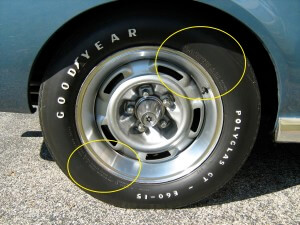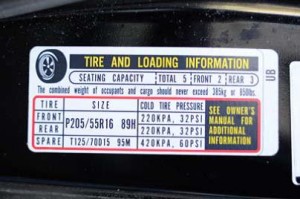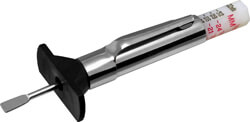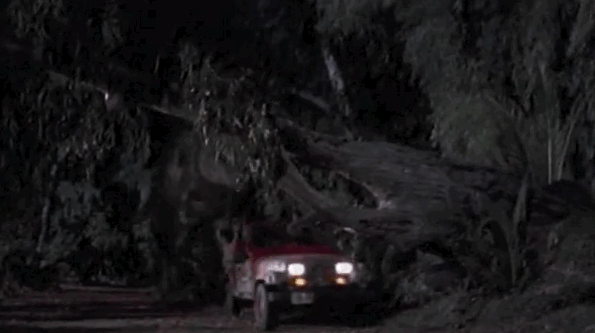Best-case scenario, your tires should last you four or five years. If you really baby them, they can last you even longer. All in all, you should easily get 100,000 to 150,000 km of driving out of a brand-new set of tires.
Keeping Your Tires At The Right Pressure
Tires have pressure recommendations stamped right on them – usually on the sidewall. It’ll look something like this:

If you look closely, you’ll find recommendations stamped into the rubber around the hubcap – highlighted in this photo by yellow circles.
In that line of tiny writing around the hubcap, the tire will state the maximum and minimum pressure recommended for that tire – usually between 30 and 50 pounds of pressure. These are the absolute extremes that the tire can handle, and anywhere between those two numbers will keep the tire happy.
But what a lot of people don’t know is that each car has a separate set of recommendations for tire pressure, which are usually more specific. You’ll find those numbers in your car manual, and sometimes you can also find it on a sticker on the inside of the driver’s side door or the glove box. It’ll look something like this:
You can see that the recommended tire pressure for this car is 32 psi, or pounds per square inch. These are the numbers you should follow when checking your tire pressure. You risk overinflating if you follow the guidelines on the tire, which – you guessed it – can cause premature wear.
Once you have your tires at the right pressure, they should keep it for a long while. I usually check and adjust the pressure when I change the oil – every three months or so.
Tires, Suspension, Steering, And Alignment
I’ll always check on your tire wear when you have your car in the shop – it’s easy enough to do a visual inspection before or after an oil change, and any mechanic worth his or her salt will do the same. Tire wear can indicate problems in suspension, steering, or alignment. I talk more about that in this post and this post.
Here’s the short and sweet of what you need to know:
- If you have underlying structural issues, your tires will wear unevenly – and a lot faster
- You will continue to have tire problems if you don’t fix a suspension or steering issue
- Proper wheel alignment will lengthen the life of your tires
Keeping An Eye On Tire Wear
Unlike other components on your car, tires don’t make any weird warning noises when they begin wearing out. You have to look to the tread to see how much life is left, and pay close attention to how the car drives. It might be useful to ask yourself a few questions at the beginning of the month:
- Is the car taking longer to stop when I brake?
- Does the car slip, slide, or squeal around sharp corners?
- Has the handling of the car waned?
If you answer “Yes” to any of those questions, it might be time to check out the condition of your tires. It’s important to keep asking these questions regularly; tires wear slowly enough that you won’t notice a huge shift in their performance. Think back to how your car drove when it had new tires and compare how it’s driving now. I’ve heard many people say their car drives like a completely new vehicle after they replace the tires.
Interpreting Wear Lines And Measuring Your Tread
Some newer tires have “wear lines” tucked into the grooves of the tread. Here’s an example of what wear bars would look like, from a Kia tire:
Wear lines signify the absolutely minimum amount of tread that it’s safe to drive with. If they’re flush with the main tread, you should change your tires right away.
You can also physically measure how much tread is left on the tire using a tire depth gauge, like this one:
This little guy is more precise than a ruler, measuring in 1/32 of an inch. You can also find a version that measures digitally.
In winter conditions, you shouldn’t use tires that have less than 5/32 of tread. In summer you can get away with 4/32 of tread, and even 3/32 of tread is okay in a pinch if driving conditions are really dry.
By the time your tires get down to 2/32 of tread, they’re officially bald and you have to replace them right away. It’s both illegal – not to mention dangerous! – to have bald tires on the road.
Even if you think you have a decent amount of life left in your tires, it’s a good idea to keep an eye on how much tread you have left. I find that the first half of tread lasts the longest. Once you’re on the second half of your tire’s life, the tread will wear much more quickly.
Swapping and Rotating Tires
Ideally, you should have a set of tires for each season – summer for summer and winter for winter. Using the right tires for the season is the number one way to lengthen the life of your tires.
I won’t go into too much detail here, but you can read more about mixing and matching tires and seasons in this post.
Finally, rotating your tires from time to time – every year or so – will also help them get the most out of life. This just means swapping the front tires with the back, because depending if a vehicle is a front-wheel drive or a rear-wheel drive tires may wear more heavily on one end of the car or the other. Rotating your tires will help them wear evenly. Think about rotating your tires whenever your car goes in for routine maintenance. It’s fairly easy to rotate the tires if your vehicle is already in the shop and up on jacks.
Storing Your Tires – Think Dark And Dry
Tires aren’t too finicky about how you store them. The only real guideline is to keep them off the bare ground and out of direct sun. Daylight and dirt are eager to break everything down – tires are pretty hardy, but even they’ll start to degrade in bad conditions.
I keep my tires in my garage, and you could also keep them in a shed, crawlspace, attic – the list goes on. Just look for anywhere dark and dry, and you’ll be set.
New tires often come wrapped in a loose plastic bag, and this just serves to keep them clean. The tires don’t care if you keep them covered in their plastic bags, but I do find it makes them easier and cleaner to transport. If you have some plastic hanging around, wrap them up. If you don’t, no worries.
How George Can Help With Tires
There are some tire problems I can help you with, and some I can’t. If you just want your summers swapped for winters and everything’s already on rims, I can do that no problem. On the other hand, if you need tires swapped from one rim to another, I don’t have the equipment to do that in the shop. Instead, I’ll recommend you to a tire specialist in town – they’ll have all the precision equipment to do it properly.
If you like, I can also show you how to check tire pressure and what to look for in tread wear. It’s quick enough to lead you through the basics after your next appointment, and it’s always easier to get a lesson from a pro like me than try and muddle through on your own.




